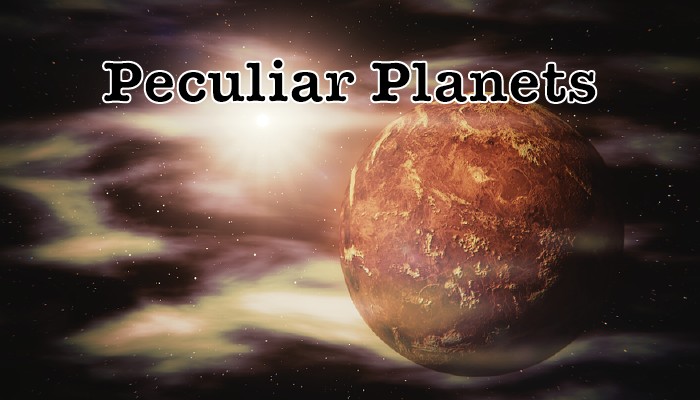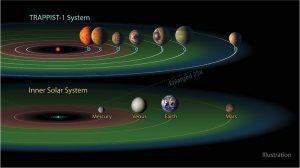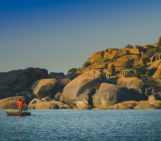
Apart from Earth, there are a lot of Peculiar Planets out there! Every 8 weeks, give or take, we look at a planetary body or system worthy of our geodynamic attention. When the discovery of additional Earth-sized planets within the TRAPPIST-1 system was revealed last year, bringing the total to 7 planets, it captured the minds of audiences far and wide. This week, two of the authors from a 2017 Nature Astronomy study on the TRAPPIST-1 planets, Lena Noack from the Department of Earth Sciences at the Free University of Berlin and Kristina Kislyakova from the Department of Astrophysics at the University of Vienna, explain more about this fascinating system.

Blog authors Lena Noack and Kristina Kislyakova
For Earth scientists, it often seems like a huge endeavour to talk about the geodynamics and other interior processes of the other planets in our Solar System like Mars or Venus. But what about exoplanets? It’s very daring! We have almost no information about the thousands of planets that have been discovered so far in other places of our galaxy. These planets orbit other stars, of which some are quite similar to our Sun whereas other stars behave very differently. But how much do we actually know about planets around these stars?
Exoplanet hunting missions like Kepler have shown that the majority of exoplanets are actually small-mass planets – not huge gas giants like Jupiter – and are often smaller than Neptune, with some being even smaller than Earth. We have a pretty good idea of what some of these planets could look like, for example we know their mass, their radius, we might even have some spectral information on their atmospheres, we know how much energy they get from their star, and we might even know something about the star’s composition. This information hints at the composition of the planetary disk from which planets are made, and how much radioactive heating they may experience during their later evolution. Putting all these pieces together gives us several clues on how the planets may have evolved over time, and is comparable to the wealth of information we had of our neighbouring planets before the age of space exploration.
However, in contrast to our Solar System, we cannot (at least not with our technological standard of today) travel to these planets. The only way we can learn more about exoplanets is if we combine geophysical, thermodynamical and astrophysical models – derived and tested for Earth and the Solar System – and apply them to exoplanet systems.

Artist’s impression of TRAPPIST-1e, ©NASA
One exoplanet system that is quite intriguing is the TRAPPIST-1 system, which has been observed by several different space and ground-based telescopes including TRAPPIST (short for TRAnsiting Planets and PlanetesImals Small Telescope, or otherwise known as a European monastery-brewed beer) and the Spitzer Space Telescope.
The system contains at least 7 small, densely-packed planets around an 8 Gyr old M dwarf. All planets have masses and radii close to Earth – from TRAPPIST-1c and -1h, which are both ¾ the radius of Earth, to TRAPPIST-1g, which is 13% larger than Earth. For comparison, Venus, our sister planet, has a radius 5% smaller than Earth, and Mars, our small brother planet, is only half the size of Earth. And the greatest news: TRAPPIST-1 is actually in our direct neighbourhood, only 39 light years away. This is literally around the corner! For comparison, our closest neighbour planet outside the Solar System is Proxima Centauri b with a distance of 4.2 light years. Its star belongs to a system of three stars, the most well-known of which is Alpha Centauri, the closest star outside the Solar System. Some day, it may actually be in our reach to travel to both the Centauri system as well as TRAPPIST-1. So we should learn now as much about these planets as possible.
What makes the TRAPPIST-1 planets truly peculiar are their tight orbits around the star – the closest planet orbits at a distance of 0.0011 AU – so only 0.1 percent of Earth’s orbit. Even the furthest planet in the system discovered so far– TRAPPIST-1h – has an orbit of only 0.0063 AU. In our Solar System, Mercury, the closest-in planet, orbits at a distance of 0.39 AU. Does this mean that the planets are boiling up due to their close orbit? Not necessarily, since TRAPPIST-1 is a very dim red M dwarf, which emits much less light than the Sun in our system. If we would place Earth around this red M dwarf star, it would actually need to orbit at a distance of about 0.0022 AU to receive the same incident flux from the star. Actually, if we look at the possible distances from the star, where (depending on the atmosphere greenhouse effect) liquid water at the surface could theoretically exist for a somewhat Earth-like atmosphere (that is, composed of gases such as CO2 and N2), TRAPPIST-1d, -1e, -1f and -1g could potentially contain liquid water at the surface and would thus be habitable places where Earth-like life could, in principle, form. Of course, for that to occur several other factors have to be just right, as well. This zone, where liquid water at the surface could exist, is called the Habitable Zone or Temperate Zone, and is indicated in green in the illustration of the TRAPPIST-1 system compared to the inner Solar System below.

TRAPPIST-1 system compared to the inner Solar System below showing the green region of a Habitable Zone. © Caltech/NASA
So, should we already book our trip to TRAPPIST-1? Well, there are other factors that may endanger the possible habitability of these otherwise fascinating planets. First of all, TRAPPIST-1 is really different from the Sun. Although it is much dimmer and redder, it still emits almost the same amount of harsh X-ray and extreme ultra violet radiation as our Sun, and in addition, produces powerful flares. For the TRAPPIST-1 planets, which are so close to their star, it means that their atmospheres are exposed to much higher levels of short wavelength radiation, which is known to lead to very strong atmospheric escape. A nitrogen-dominated atmosphere, like the one Earth has, would likely not be stable on the TRAPPIST-1 planets in the habitable zone due to exposure to this short wavelength radiation for gigayears, so carbon dioxide Venus-like atmospheres are more probable. Besides that, stellar wind of TRAPPIST-1 may be very dense at planetary orbits, powering strong non-thermal escape from planetary atmospheres and leading to further erosion of the atmosphere.
Another interesting feature of the M dwarfs, especially such low-mass ones as TRAPPIST-1, is their extremely slow evolution. On the one hand, this means very long main-sequence life times of such stars, with stable radiation levels for many gigayears. Could this maybe allow very sophisticated life forms to evolve? On the other hand, when these stars are young, they go through a contraction phase before entering main sequence, which is much longer than the contraction phase of G-dwarfs such as the Sun. During this phase, the stars are much brighter and hotter than later in their history. For TRAPPIST-1 planets this would mean they have been grilled by hot temperatures for about a billion years! Can they still retain some water after such a violent past? Can life form under such conditions? We don’t really know. In any event, it seems that water retaining and delivery might be a critical factor for TRAPPIST-1 planets’ habitability.
Since the planets are so densely-packed in the system, the masses of neighbouring planets as well as the mass of the star have a gravitational effect on each other – just as the Moon leads to high and low tides of Earth’s oceans. Only, the tidal forces acting on the TRAPPIST-1 planets would be much stronger, and could lead to immense energy being released in the interior of the planets due to tidal dissipation. Furthermore, the star itself appears to have a strong magnetic field. An electrical current is produced if a conductive material is embedded in a changing magnetic field, which is used, for example, to melt iron in induction furnaces. Similarly, the mantle of rocky planets are conductive and can experience enhanced energy release deep in the upper mantle due to induction heating.
Both induction heating and tidal heating can have a negative effect on the potential habitability of a rocky planet, since strong heating in the interior can be reflected by equally strong volcanic activity at the surface. This would lead to a hellish surface to live on! The interior may even be partly molten, leading to subsurface oceans of magma, which actually may be the case for TRAPPIST-1b and -1c. Even TRAPPIST-1d may be affected by strong volcanic events due to both induction and tidal heating of the interior. TRAPPIST-1f, -1g and -1h might be too cold at the surface to have liquid water, and might rather resemble our water-rich icy moons orbiting around Saturn and Jupiter. Hence TRAPPIST-1e, which receives only a little less stellar flux compared to Earth, may be the most interesting planet to visit in the system.
But what would life look like on such a planet?
The tidal forces described above also lead to a different effect: the planets would always face the star with only one side (this is called a tidal lock). Therefore, planets would have a day side that was always facing the star, and a night side immersed into eternal darkness and where no light ray is ever received from the star. Such a tidally-locked orbit is similar to the Moon-Earth system, as the Moon shows us always the same face – the “near-side” of the Moon. The other side, the “far-side” of the Moon, is only known to us due to lunar space missions. Can you imagine living at a place where it never gets dark? On the other hand, the luminosity from the star is very weak. Life on the TRAPPIST-1 planets might therefore actually look different than on Earth. To obtain the needed photons used in photosynthsesis (if this process would also evolve on these planets), life might evolve to favour a large variety of pigments that would enable it to make use of the full range of visible and infrared light – in other words, plants on these planets would appear black to us.
TRAPPIST-1 planets certainly still harbour many mysteries. They are a very good example how diverse the planets in the universe can be. If we set our imagination free… Black trees under the red star in the sky, which never sees a sunrise or sunset, powerful volcanoes filling the air with the ash and shaking the ground.
Very different from our Earth, isn’t it?
Further reading: Kislyakova, K., Noack, L. et al. Magma oceans and enhanced volcanism on TRAPPIST-1 planets due to induction heating. Nature Astronomy 1, 878-885 (2017). Gillon, M. et al. Seven temperate terrestrial planets around the nearby ultracool dwarf star TRAPPIST-1. Nature 542, 456-460 (2017). Kiang, N. et al. The Color of Plants on Other Worlds. Scientific American, April 2008, 48-55 (2008). Barr, A.C. et al. Interior Structures and Tidal Heating in the TRAPPIST-1 Planets. Astronomy and Astrophysics, in press. Luger, R. et al. A seven-planet resonant chain in TRAPPIST-1. Nature Astronomy 1, 0129 (2017). Scalo, J. et al. M stars as targets for terrestrial exoplanet searches and biosignature detection. Astrobiology 7(1), 85-166 (2007). Ramirez, R.M. and Kaltenegger, L. The habitable zones of pre-main-sequence stars. The Astrophysical Journal Letters 797(2), L25 (2014).





Muhammad Saim
Water indeed, water, water everywhere and the necessary to survive. Scientists now say a number of the TRAPPIST-1 planets comprise extra water than even the oceans of the Earth up to 250 times more. The Number of total Trappist 1 Solar systems are 7. The planets have been named TRAPPIST-1b, 1c, 1d, 1e, 1f, 1g, and 1h. TRAPPIST-1d, the third planet out, and TRAPPIST-1e, the fourth. Those two says Grimm, “are the most likely to have liquid water on them.” You can check out more about update on Trappist -1 Solar system at http://everydayscience.blog/trappist-1-solar-system/